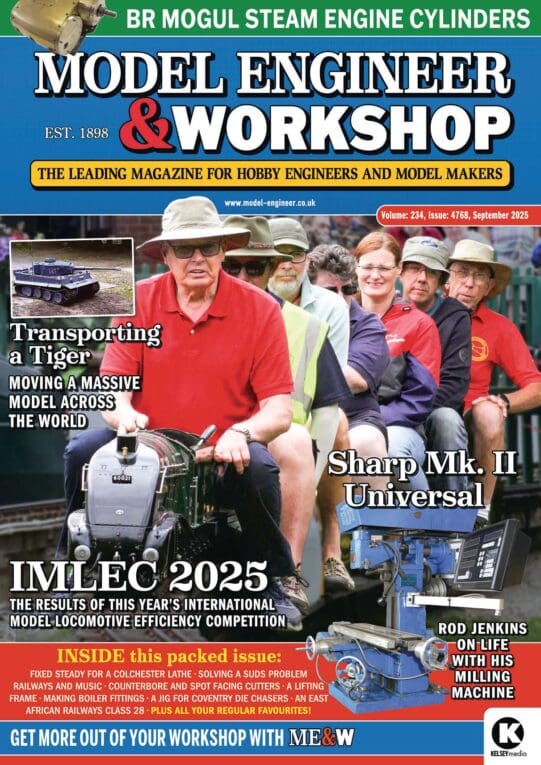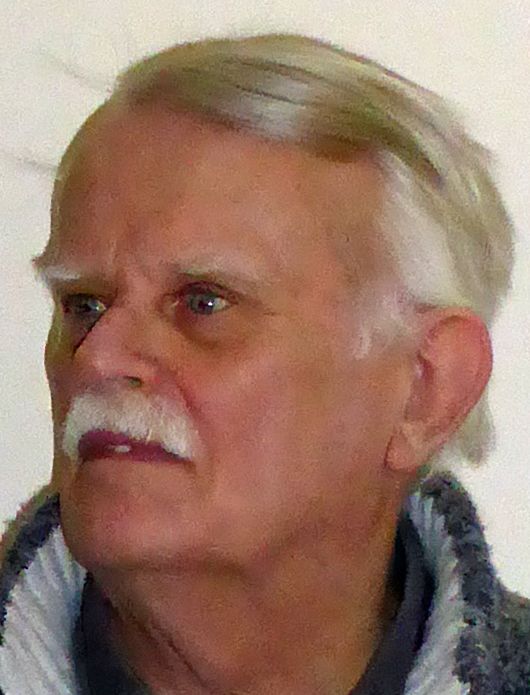 Recently, I moved both house and home workshop. The new workshop had minimal lighting and unsafe electrics, so a complete rethink was called for. The existing lighting and power points were ripped out and a fresh start made using more suitable modern equipment, selected to make the best of the space available. On the lighting front quite a lot has changed, with the arrival of low energy lighting and especially the arrival of useful Light Emitting Diode (LED) devices that are ideal for some workshop uses.
Recently, I moved both house and home workshop. The new workshop had minimal lighting and unsafe electrics, so a complete rethink was called for. The existing lighting and power points were ripped out and a fresh start made using more suitable modern equipment, selected to make the best of the space available. On the lighting front quite a lot has changed, with the arrival of low energy lighting and especially the arrival of useful Light Emitting Diode (LED) devices that are ideal for some workshop uses.
Traditionally, Home Workshops made do with unsuitable but inexpensive (i.e. free), cast off domestic lighting. Invariably workshops have fluorescent tubes for overhead lighting and ‘warm white‘ incandescent bulbs for close up lighting. This general approach was followed in my new workshop but some energy and safety improvements were called for.
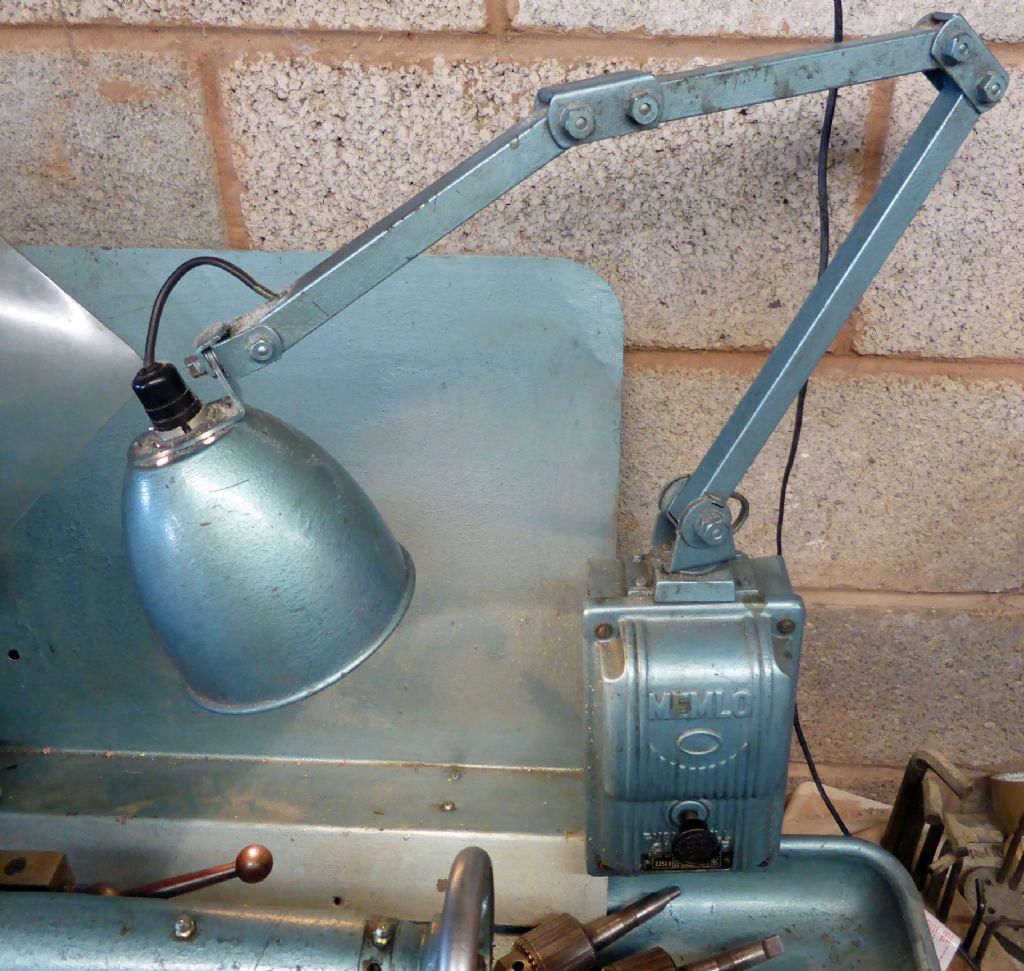 1
1
Enjoy more Model Engineer reading in the monthly magazine.
Click here to subscribe & save.
Photograph 1 shows a low voltage incandescent light fitted to an 'industrial cabinet’ Myford Super 7 made in the 1950’s. The blue MEMLO unit is a cast iron box containing a pull switch and step down transformer to 24 or 12 volts and attached adjustable lighting arm. The bulb is unprotected from swarf or coolant and has a very primitive reflector. Mine gives a very yellow-orange light but has a very long bulb life. I have found it useful because the adjustable arm allows the light source to be positioned very close to the work. Both 240V single phase and 440V 3phase versions of these MEMLO machine lights often turn up in workshop clearances and attached to old machine tools. They work and seem pretty bomb proof but there are more modern solutions that use less power and give a whiter light.
What is Ideal Lighting?
I suppose natural sunlight is the lighting our eyes were designed or evolved to use best. In an ideal world one might aspire to an artist’s studio lighting. Studio lighting often had natural lighting provided by a North facing sky light to render colours as natural as possible. Of course, in the Southern Hemisphere it has to be a South-facing skylight. However, northern light in the Northern Hemisphere isn’t a constant and varies in hue by location, time of day, month and the weather.
I’m sure very few of our workshops have artist’s studio natural lighting and in any case we often work at night, on dull days, in cramped conditions with small windows, etc. Whilst we don’t think we need good studio quality workshop lighting most of us notice that as we get older we need more light intensity and in my case whiter lighting is becoming more desirable. Those of us who actually manage to complete a scale model and paint it in authentic colours will find that they need very good studio type lighting to get a really good paint job with an accurate colour match.
Home Workshop activities often involve Intricate mechanical and detail drawing work, both of which require more light intensity at the workbench, whatever your age. The lighting has to be in the right place, on the work and not directly into the eye.
Even in our ideal artist’s studio natural lighting isn’t constant and it’s worth taking a few minutes to study some of the factors that provide good lighting. The key factors are colour temperature in degrees Kelvin, Colour Rendering Index (CRI) and Luminosity (brightness).
Colour Temperature
It’s called colour temperature because the scale originated from light emitted by carbon, a ‘black body’, heated to different temperatures. It’s customary to quote colour temperatures in degrees Kelvin, K, which is the temperature above absolute zero, -273.85 Celsius. E.g. Carbon heated to 2700 K (2426.85 C) gives a yellowish-white light while carbon heated to 5400 K (5126.85 C) gives a bluish- white light. Confusingly, the bluer tone of higher colour temperatures is usually interpreted as cool, whilst lower colour temperatures are perceived as ‘warm.
How does this relate to our Artist’s North light?
A standard domestic incandescent filament bulb is normally about 2500K, a so-called ‘warm white light’, frequently found in domestic lighting. Generally domestic warm white lighting has an orange/yellow colour cast. Infinitely better than a candle though!
An office overhead fluorescent light might be 4000 K to 5000 K, a cooler ‘white light’. Noon Daylight at 5500 K is a good blue-white light. North Light, blue sky at 7500 K plus is definitely too harsh a blue-white colour for most workshop purposes.
Relying on Kelvin isn’t the only consideration for a light source. (These are called luminaires in the UK Building Regulations). Having a cheap light that delivers 5000K but hasn’t got the full spectral range or has a distorted spectrum of colours might give pretty disappointing colour rendering results.
CRI, Colour Rendering Index
Normal daylight has a CRI of 100 so that’s what would one expect in a lamp that will give excellent colour rendering. In practice a CRI of 90% plus is possible and 98% plus is desirable for some painting and colour matching tasks. A high CRI indicates not too many peaks and blank spaces in the spectral power distribution. Specialist daylight bulbs can achieve a CRI of 98% but these are especially manufactured and probably expensive products. As consumers, our biggest problem is finding any CRI data on luminaires intended for domestic use; so you may have to dig about in the manufacturer’s data sheets, search the web and read the fine print on the box. Many domestic luminaires don’t exceed a Colour Rendering index of 70 to 85, especially some of the compact fluorescent low energy bulbs. (CFLs)
Remember those greenish high-pressure sodium streetlights that made everybody look ill? One would expect them to have a very low CRI and they do; high-pressure +20% and the yellow low-pressure is even worse at -40%.
Lumens and Light output
How much luminosity or brightness can one expect? Wattage is a measure of how much electrical energy a light uses, not how bright it is. Efficiency of conversion of electrical energy to luminosity is the key and we need to consider how the available luminaires actually work. Energy efficient lighting is more important than it was, due to the escalating cost of electrical energy, and ‘save the planet’ eco-initiatives. Light output is usually measured in lumens, Lu, and is a measure of all the visible light given out by the luminaire.
Types of Luminaires
In the following discussion of workshop lamp types I have deliberately omitted metal halide or high intensity, high efficiency discharge lamps that have been developed for outdoor sports events, wide area overhead lighting and those very annoyingly bright xenon automotive headlamps.
Tungsten filaments
Incandescent bulbs, coiled coils of tungsten wire in a glass envelope containing an inert gas, tend to give a very soft yellow-orange light of around 2500 K, and have a quite a short life (perhaps 1000 hours if there is little vibration, even less if there is more). They give as little as 16 lumens per watt of input energy or an energy conversion efficiency of less than 5% to light, the rest being heat. Increasing the current through the filament raises the colour temperature but reduces the life of the lamp, as in the old photographic ‘flood lamp’. The limit is governed by the melting point of the tungsten filament. For some reason 220 volt filament bulbs are slightly less energy efficient than 110V ones, something to do with the filament thickness, perhaps?
A 40-watt 220/240 volt incandescent lamp might produce as little as 450 lumens. Of course domestic incandescent lamps are now withdrawn from Europe as an energy saving measure. Low voltage and special use ‘industrial’ bulbs are still available, however. Current UK building regulations apparently state that up to 25% of home lighting can still be energy inefficient. Naughty lighting!
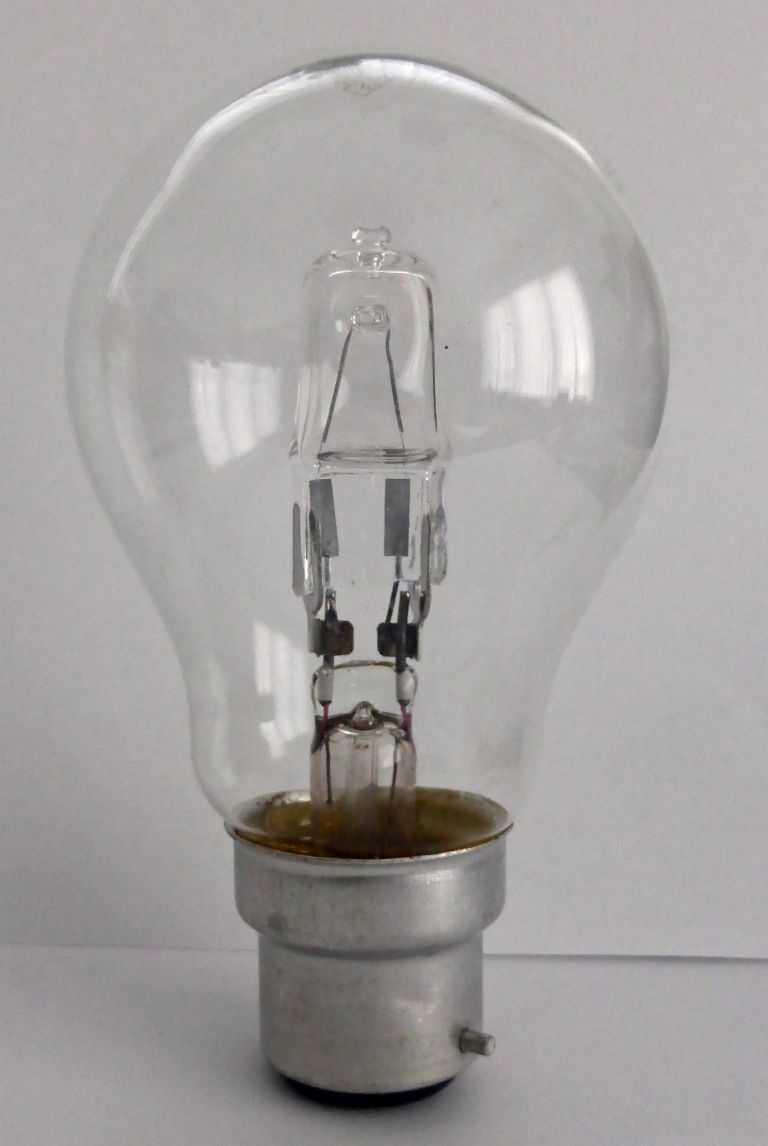 2
2
Halogen bulbs still contain a tungsten filament in a ‘glass envelope’, photo 2. They are able to operate at higher colour temperatures by increasing the gas pressure, which raises the filament melting point and the introduction of a halogen, like iodine or bromine, to react with tungsten metal vapour and redeposit tungsten back onto the filament. The outer glass package is usually ‘quartz’ and gives rise to the name ‘Quartz Halogen Bulb’. The colour temperature can be higher than the incandescent lamp and the bulb size is very much reduced for a given wattage. Sadly halogen bulbs are not a lot more energy efficient than the standard incandescent and they run extremely hot. Typically they give perhaps 29 watts energy input for our 450 lumens light output. Incandescent/halogen bulbs of 3200K can have a CRI close to 100.
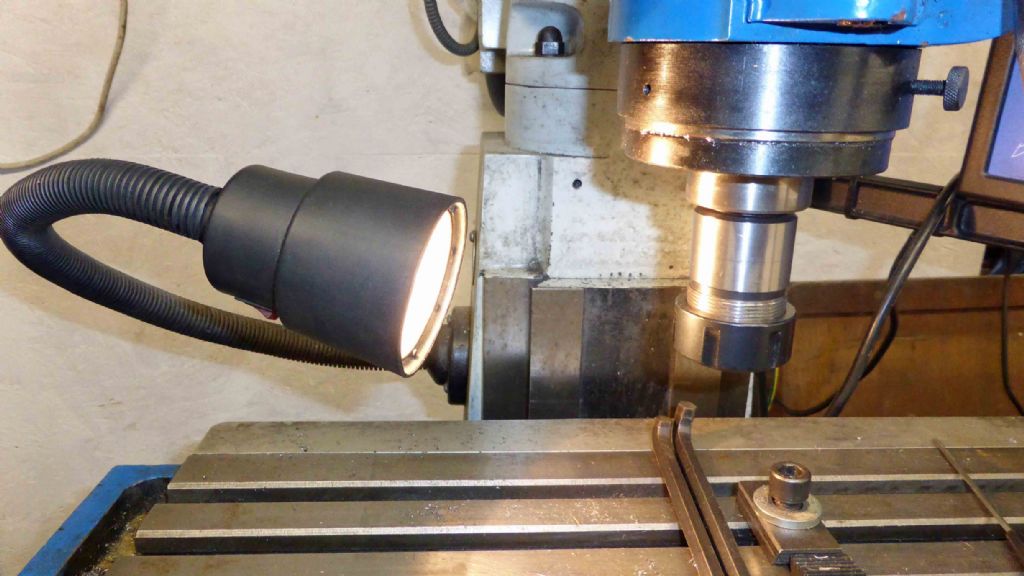 3
3
My Chester 6”x26” vertical mill, around 10 years old, was supplied with a with a low voltage halogen spotlight photo 3. The light from this machine light is yellowish but at least the bulb is protected from flying hot metal behind a glass sheet and it can be positioned close to the work with the goose neck support arm. I find I have to remove the protective glass shield and give it a good clean, as oil seems to burn onto the hot glass. A work light like this is very desirable I find and if the mill didn’t have one I would have added a more sophisticated Quartz Halogen spotlight or LED light.
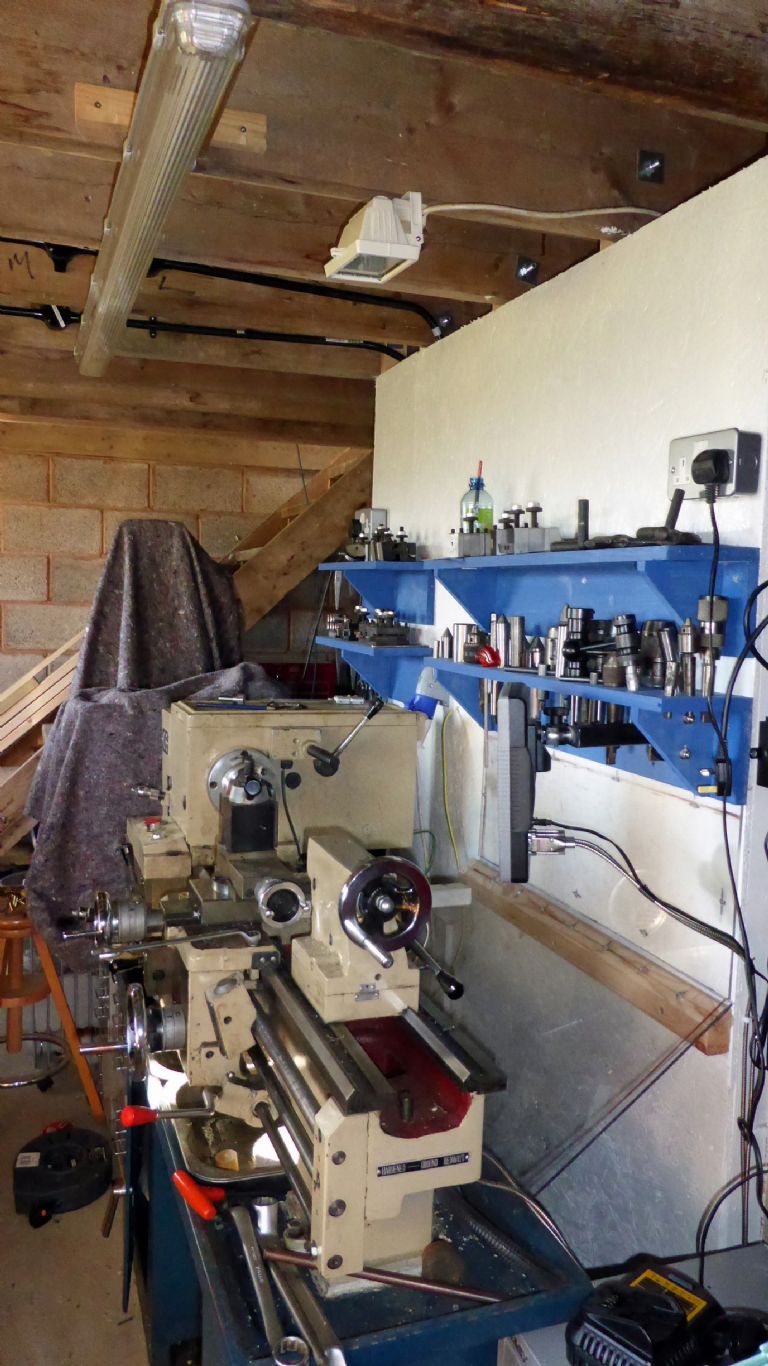 4
4
I have, for some years, used ceiling mounted Halogen floodlights (security lights) over several of my machines. On moving workshop, I again installed some 140Watt weatherproof IP 54 units at ceiling height above one of my lathes, photo 4. Although I have a fluorescent strip light close by, the security light makes a real difference and it is safer because of the IP 54 level of protection.
Whilst not being very energy efficient, these security floodlights do give a comparatively white light and the downward reflected heat is a definite bonus in a cold workshop. I find glare isn’t a problem provided the light is mounted above head height. Notice that I have painted the wall behind the lathe white, this helps a lot with the general lighting. These security lights are very cheap units, especially when bought without security features like motion detectors and timed shut down. The units I have use R7S end caps and are rated at 2550 Lumens and 3000K. These units are dimmable but why would you want to? Recommended, if you overlook the electrical input requirements and most designs are IP rated. I.e. enclosed and splash proof.
You may have noticed that ‘Eco Halogen’ bulbs are now being offered and appear to be halogen bulbs built into a traditional glass envelope (photo 2) with conventional bayonet or screw bases. These units offer slightly superior energy efficiency, using 30% less than an incandescent filament bulb and are Energy rated C under EU regulations. It appears that the outer glass envelope has been coated with a heat reflective coating and the gas inside is Xenon. If you are still using incandescent bulbs in your workshop these Eco Halogen bulbs could be a valuable improvement at reasonable cost and modestly lower energy input.
Compact Florescent Lamps. (CFL) (Low energy lamps)
These are a miniaturised version of the office overhead fluorescent strip light. Roughly 9 watts input will produce 450 lumens and the light colour can be tailored by manipulation of the phosphor coating inside the glass envelope. Photograph 5 shows the type of bulb which most will immediately recognise as the ‘energy efficient light bulb’. These are available as screw in or push and twist replacements for the old incandescent light bulb. They save energy, last a long time (over 10,000 hours but this is shortened by repeated on/off operation).
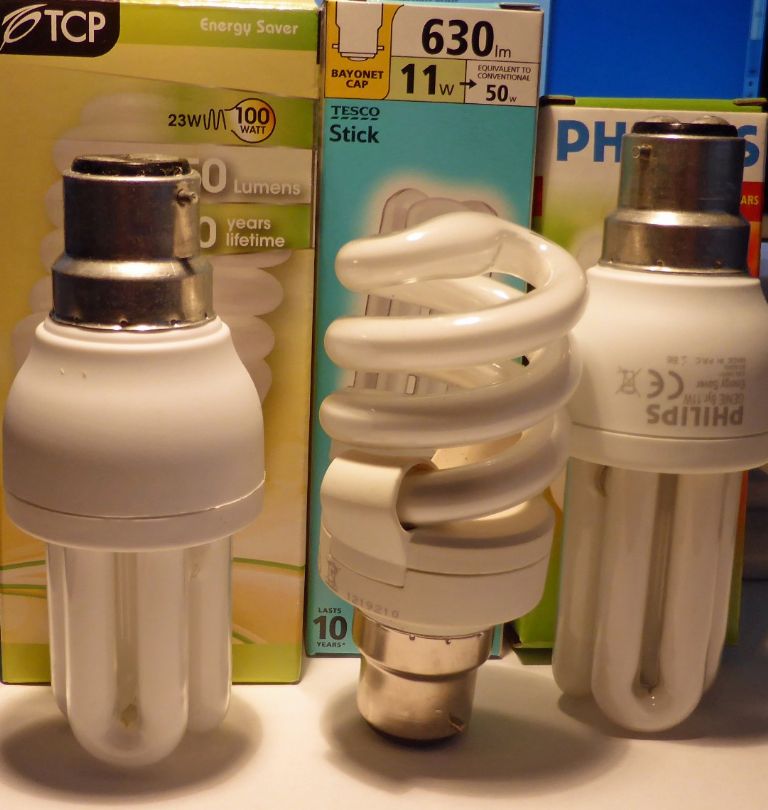 5
5
Despite all their energy saving performance CFLs annoy many users because they don’t achieve full brightness for some seconds; this is especially true in a cold workshop and some designs seem worse than others in this respect. These CFL bulbs contain electronic ballasts, which is one reason why they cost more than filament bulbs.
Millions of these CFLs were distributed ‘free’ in the UK by Electricity Supply Companies in preparation to the switch over to low energy lights a few years ago. By shopping around one can find 5000K+ CFLs and these give a good white daylight colour temperature and quite acceptable CRI. These are definitely worth searching for, in my opinion. I try to avoid those offering ‘warm soft white’ 2700K bulbs. Some manufacturers use all sorts of names to avoid quoting degrees Kelvin. Colour rendering of about 80% seems common.
Normally a 23-watt CFL is quoted as 100-watt equivalent. CFLs show a huge energy saving over filament bulbs, though some users maintain that the Industry exaggerates the quoted wattage equivalent compared to a filament bulb.
Some CFLs can be dimmed, most not, so read the box before purchase. A typical CFL box will have a panel of symbols similar to this that tell you most of what you need to know. Notice that CRI is missing from this particular one. See photo 6 for the general label and photo 7 for the efficiency label.
 6
6 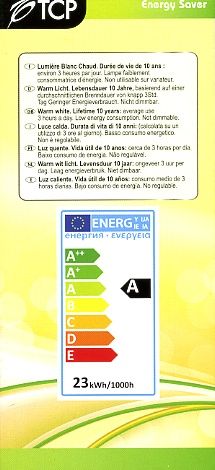 7
7
CFLs contain toxic mercury and many countries have collection schemes for end of life units to stop mercury escaping into the environment via landfill. The mercury is recovered and recycled. Without the phosphor coatings the light produced by CFLs would only be the mercury emission lines, which contain a lot of Ultra Violet. UV is not good for your skin or your eyes. To get the colour temperature required a mix of different phosphors is used as a coating inside the glass envelope. Phosphors absorb UV and re-emit it as visible light.
Because most electronic ballasts in CFLs operate at a much higher frequency than the 50 or 60 Hz mains frequency, combined with the persistence of the phosphors, the risk of stroboscopic effect is apparently quite small. The stroboscopic effect is observed when moving objects appear stationary under a flashing light. Remember the Old John Wayne movie Stagecoach where the wheels appeared to turn backwards or were static? There must have been serious Industrial accidents in the past with the old fluorescent tubes with mains frequency ballasts.
Fluorescent ceiling lights
Surely nothing has changed in these since they were first appeared in the 1930’s? I have recently replaced some old and very basic magnetic ballast domestic tubes (the ones with the screw in starter tubes on the side) with modern IP65 weatherproof K8 tubes with electronic ballasts. Photograph 4 also shows a new 5-foot unit mounted above one of my lathes. I find these lights come on virtually instantly, are quiet, don’t flicker and I don’t have starters to replace and of course the light has a useful degree of mechanical protection from its polycarbonate cover. In all, I have now installed 6 of these units in my workshop, in the room above and in the attic.
The electronic ballast also gives slightly better energy efficiency than the magnetic type and tubes are available to provide a range of K values. The tubes supplied with these units were 4000K, 5200Lm (90Lm per watt) cool white. Different manufacturers quote expected life of the tube between 10,000 and 20,000 hours. You can always change the tube for a colour temperature that suits you.
Plug in replacement tubes using light emitting diodes (LEDs) are available for shorter tubes but at the moment look to be uneconomic for home workshop use, at perhaps ten times the price of glass fluorescent tubes and little additional energy saving.
The electronic ballasts operate the tube at a much higher frequency than the old magnetic type and the risk of stroboscopic effects is much reduced. It is said that some electronic ballasts can cause electromagnetic interference but I have no first hand evidence of this. Should you want to dim your lights check before you purchase. Some can be dimmed, some cannot.
Light Emitting Diodes. (LEDs)
Light emitting diodes have been around for years as very low power indicators in electronic equipment. Photograph 8 shows a selection of these indicators.
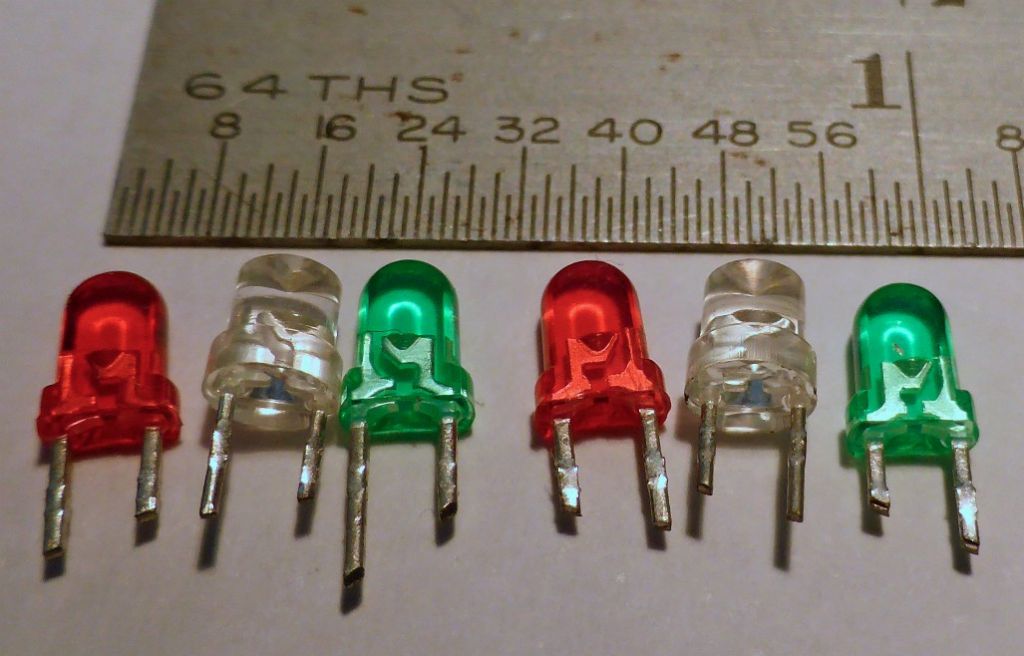 8
8
These are fairly old examples. The actual diode, a junction between two semiconductor alloys isn’t visible in this photograph, just its support framework inside the moulded lens. The colours shown here are the plastic protective encapsulations. Early LEDs only gave a red light but gradual development has added more colours by changing the alloys. The requirement for UV emitting LEDs for Blue Ray DVD players finally completed the colour range. Having UV emitters allowed the use of phosphors to give wide spectral range ‘Super Bright’ LEDs.
LEDs are very efficient at converting electrical energy to light, at least as efficient as CFLs and they have exceptionally long lives of 25,000 hours plus. They don’t contain any mercury so disposal shouldn’t be an issue.
Driving LEDs isn’t as straightforward as an incandescent filament bulb. They only emit light when current flows through them in one direction and the voltage required to start light emission varies with the alloys used. They should always be used with a DC supply and a series resistor, the value of which depends on the type of LED (LED plug in replacements for 240V bulbs have recently become widely available, I have found them very effective – Ed.) These indicator LEDs only consume a few mill-watts of electrical power but are exceptionally useful as internal lights in model trams and trains and the like. They use very little power, last a long time and don’t get hot. They are complete replacements for the old ‘grain of rice’ miniature filament bulbs.
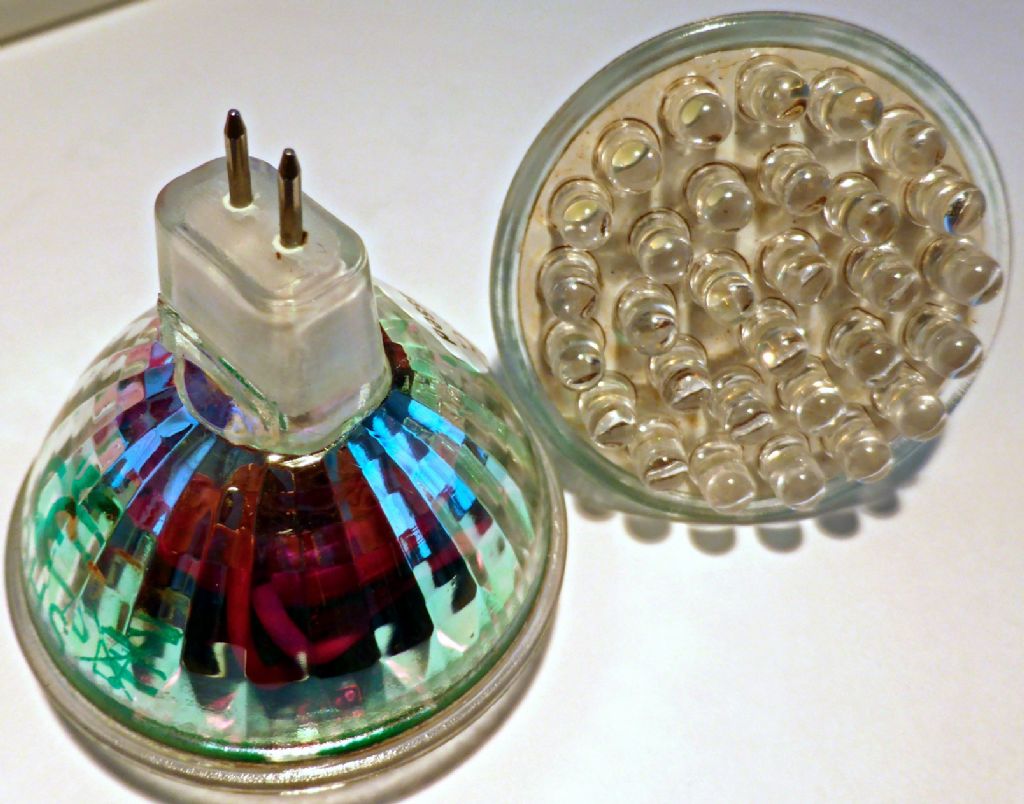 9
9
Photograph 9 shows a fairly recent MR16 LED downlight (spotlight) which is rated at 12volt AC/DC 1.8 watt that claims the performance of a 30 watt halogen. As you can see it’s constructed with 30 individual LEDs mounted in a glass reflective envelope. It has colour temperatures of ‘day white 6000-6500K or ‘warm white’ 3200-3500K. Plugging this into an existing circuit produced a brief flash of light then it extinguished! The existing transformer produced too high a voltage at the new lower current and the internal circuits shut the bulb down. Clearly specialised LED drivers are required.
 10
10
Photograph 10 shows a LED light strip and its power supply (driver) sold to provide lighting in display cabinets. The strip can be extended by plugging units together. These are examples from the IKEA Ledberg range.
The small yellow items are surface mounted LEDs and the even smaller black dots the resistors. The driver is ‘intelligent’ and can handle different numbers of strips, each being about 0.6 watts from 7 LED’s. Should you have a model display cabinet these strips could be ideal lighting.
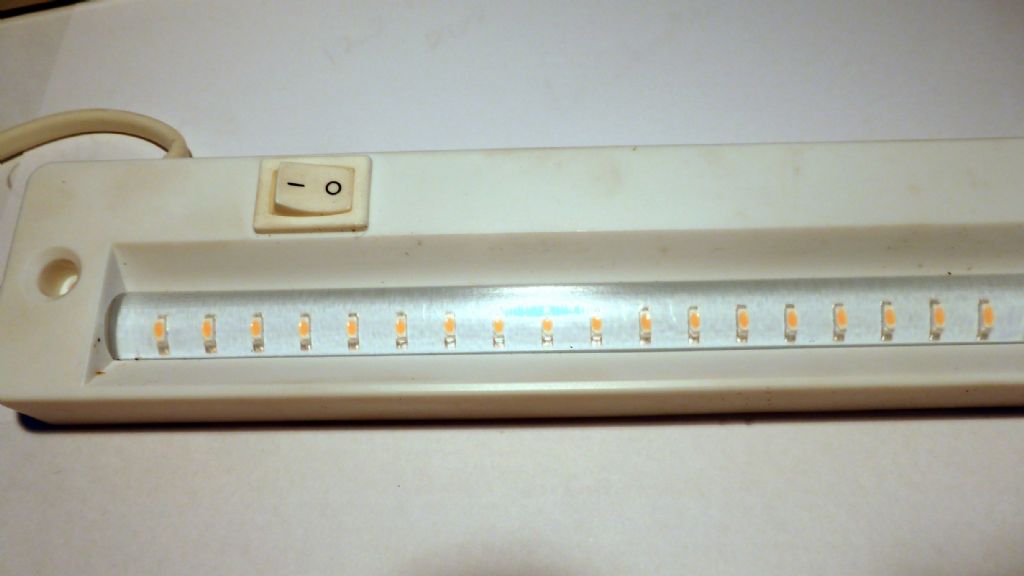 11
11
Photograph 11 shows a similar 37 SMD LED strip light that I have used on one of my machines for local highlighting and to illuminate a gear hobber at the Midlands ME Show. Quite a number of visitors asked where the light came from. The total power is 3.7 watts maximum and the electronic driver is internal to the unit. Again the LED’s are the yellow-orange dots.
 12
12
Photograph 12 shows 2 different versions of IKEA Jansjo 3 watt LED desk lamps. Where do IKEA get these names from? These lamps have proved useful in my workshop on the drilling machine and for marking out work. Like all the IKEA LED lamps I have seen they are ‘warm white’ 2700 K. IKEA quote a very long life and the LEDs are not designed to be replaced.
A friend who operates a small lathe and a mill in a garage with no mains electricity, using a 12 volt car battery and an inverter for all his workshop power, found that two of these mounted either side of his mill column gave excellent results. I have to agree. They contain a single SMD LED and I think represent about the minimum power that is useful for detailed close up work.
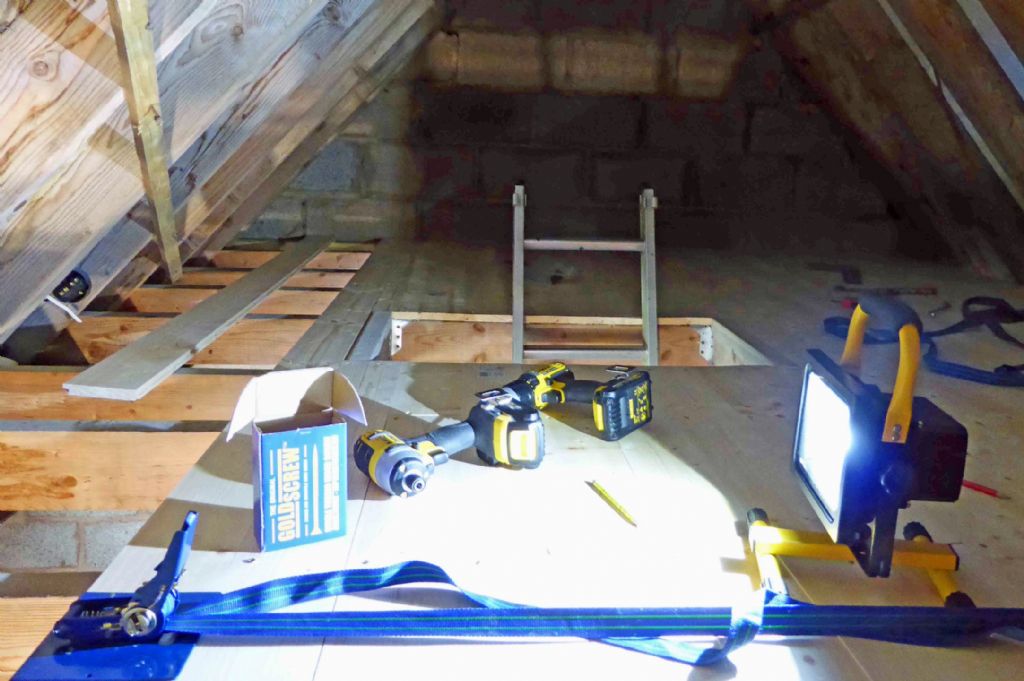 13
13
Photograph 13 shows a 10-Watt LED portable work light that has proved invaluable when I was installing T&G wooden flooring in my loft. It is powered by an internal rechargeable battery that can be recharged from the mains or from a car cigarette lighter socket. It has a single COB LED about the size of a postage stamp. It produces 900 Lm for 3 hours with a CRI of 70+ and a colour temperature of 5500K, ‘Cool White’. 90 Lm per watt seems to be the present limit of the LED technology for high powered LEDs. COB stands for ‘chips on board’ and is a method of mounting multiple chips spread out over a wider area to cut glare.
Since I bought this work light from Screwfix it has had a lot of use on all sorts of jobs around the house and workshop.
The Consumer Association’s Which reports that in their tests the life of some LED luminaires isn’t as long as some manufacturers claim.
Conclusions
I hope I have caused you to consider what you are using to light your workshop and perhaps to make some changes. Many of the changes I have described are being driven by energy saving demands and safety. In my opinion LED technology has a way to go, it’s still developing. I know LED lighting has disappointed some people and the only sensible advice must be to try before you buy.


